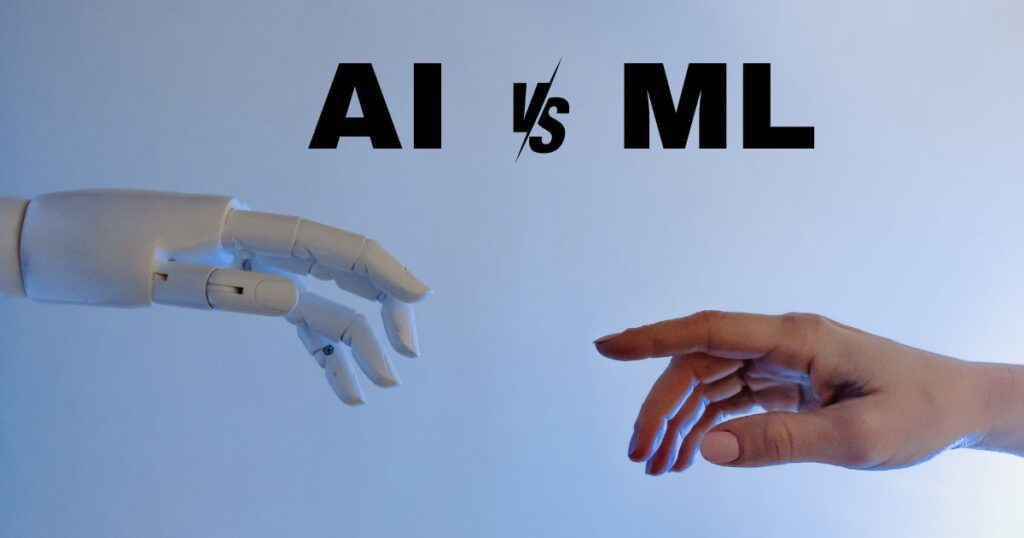AI vs ML: The Complete Beginner's Guide to Understanding the Difference (2025)
Table of Contents
• Introduction
• Understanding Artificial Intelligence (AI)
• What is Machine Learning (ML)?
• Key Differences Between AI and ML
• Which Should You Learn First?
• Real-world applications and Examples
• Getting Started with AI and ML: Code Examples
• Career Opportunities and Future Prospects
• Conclusion
• FAQs
Introduction
AI and ML are hot buzzwords, with many using these terms interchangeably, although their nature remains rather dissimilar. This guide delineates the fundamental distinctions that beginners must understand about AI and ML to have a clear idea of what these technologies are and how they operate within the context of our digital world today.
Artificial Intelligence(AI) s a general term used to describe certain machines that function in a manner we’d generally deem “smart” or “intelligent”.”At the basic level, AI is an attempt to create automated systems that can call upon human intelligence to perform certain tasks that require a degree of human cognition.
Major Principles of AI:
• Problem-solving capabilities
• Pattern recognition
• Natural language understanding
• Decision making
• Adaptative learning
What is Machine Learning?
Machine Learning is, in fact, a subdomain of AI that concentrates on how to create computer programs that can access data and learn from it. The fundamental concept behind ML is that systems can learn from data, based on patterns, and can act on them with only a little intervention from humans.
Types of Machine Learning:
1. Supervised Learning
2. Unsupervised Learning
3. Reinforcement Learning
Key Differences Between AI and ML
Let’s break down the fundamental differences between AI and ML:
Aspect | Artificial Intelligence | Machine Learning |
Scope | Broader concept aimed at creating intelligent systems | Subset of AI focused on data learning |
Goal | Creating intelligent behavior | Improving accuracy through data |
Data Dependency | Can work with structured or unstructured data | Requires structured, labeled data |
Output | Decision-making based on intelligence | Predictions based on patterns |
What you should learn first?
For beginners entering the field, starting with Machine Learning often provides a more structured learning path. Here’s why:
1. More concrete concepts
2. Clear mathematical foundations
3. Immediate practical applications
4. Abundant learning resources
5. Strong job market demand
Some real-world applications and examples:
AI applications:
- Virtual assistants: Siri or Alexa
- Drivers of autonomous vehicles
- Smart home systems
- Medical diagnosis
- Ai in games.
ML applications:
- Recommendation systems
- Detection of fraud
- Spam detection
- Image recognition
- Predictive maintenance
Getting Started with AI and ML: Code Examples
Basic Machine Learning Example (Python)
# Simple Linear Regression Example
from sklearn.linear_model import LinearRegression
import numpy as np
# Sample data
X = np.array([[1], [2], [3], [4], [5]])
y = np.array([2, 4, 6, 8, 10])
# Create and train the model
model = LinearRegression()
model.fit(X, y)
# Make predictions
prediction = model.predict([[6]])
print(f”Prediction for input 6: {prediction[0]}”)
Simple AI Decision-Making Example
def simple_ai_decision(temperature, humidity):
if temperature > 30 and humidity > 60:
return “Turn on AC”
elif temperature < 20:
return “Turn on heater”
else:
return “Maintain current settings”
# Example usage
current_temp = 32
current_humidity = 65
decision = simple_ai_decision(current_temp, current_humidity)
print(f”AI Decision: {decision}”)
Career Opportunities and Future Prospects
The field of AI and ML offers numerous career paths:
- Machine Learning Engineer
- AI Research Scientist
- Data Scientist
- AI/ML Solutions Architect
- Computer Vision Engineer
- NLP Engineer
Average Salary Ranges (2025):
- Entry Level: $80,000 – $100,000
- Mid-Level: $120,000 – $150,000
- Senior Level: $150,000 – $200,000+
Conclusion
Not only for AI professionals, but it is also very important for anyone looking to enter the field of artificial intelligence to understand the difference between AI and ML. While AI stands for a broader machine intelligence notion, ML serves as the basis for developing systems that learn from experience and improve without being highly programmed. Starting from ML, there is an idealized entrance into the exciting field with numerous opportunities for career development and growth.
FAQs
1. Can machine learning exist without AI?
No, ML is a subset of AI and requires the broader framework of artificial intelligence to function effectively.
2. How long does it take to learn ML basics?
With dedicated study, you can grasp ML basics in 3-6 months, assuming you have a background in programming and mathematics.
3. Do I need advanced math for AI and ML?
Yes, a strong foundation in statistics, linear algebra, and calculus is important, especially for ML.
4. What programming languages should I learn first?
Python is the most popular choice for both AI and ML, followed by R and Julia.
5. Is AI harder than ML?
AI can be considered broader and more complex as it encompasses multiple disciplines, while ML focuses specifically on data-driven learning algorithms.



